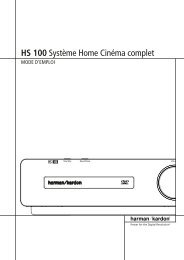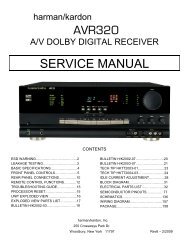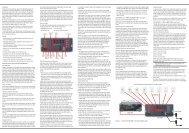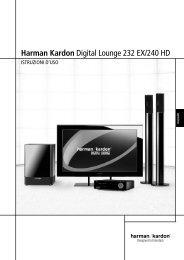Owners Manual - AVR 1600 - Harman Kardon
Owners Manual - AVR 1600 - Harman Kardon
Owners Manual - AVR 1600 - Harman Kardon
Create successful ePaper yourself
Turn your PDF publications into a flip-book with our unique Google optimized e-Paper software.
to enjoy the sound mix created by your favorite movie and music<br />
artists.<br />
BXr: Enhances bass performance when playing MP3 tracks.<br />
Select ON, or leave at the default OFF setting for non-MP3 audio.<br />
tone: Determines whether the treble and bass controls are<br />
active. When it’s off, the tone controls are “flat”, with no changes.<br />
When it’s on, the bass and treble frequencies are boosted or cut,<br />
depending upon the tone-control settings. When an analog audio<br />
source is in use and the 2-Channel Stereo surround mode is selected,<br />
setting the TONE to OFF places the unit in analog bypass mode.<br />
Bass and treble: Boost or cut the low or high frequencies by<br />
up to 10dB by using the Buttons to change the setting by 2dB<br />
at a time.<br />
6-/8-channel Inputs<br />
The 6-/8-Channel Analog Audio Inputs are used when playing<br />
certain multichannel discs (DVD-Audio, Blu-ray Disc, SACD and<br />
HD-DVD) on a player that decodes the audio and outputs it via its<br />
multichannel analog audio outputs but not via its HDMI output.<br />
HDmI-equipped multichannel Disc player:<br />
• Connect the player’s HDMI output to one of the <strong>AVR</strong>’s HDMI<br />
Inputs. No other connections are necessary.<br />
• Make sure the HDMI input is selected as the source and the<br />
Audio Input in the Input Setup menu.<br />
HDmI-equipped multichannel Disc player<br />
that Does not output multichannel audio<br />
via an HDmI connection:<br />
• Connect the player’s HDMI output and its multichannel analog<br />
audio outputs to one of the <strong>AVR</strong>’s HDMI Inputs and to the <strong>AVR</strong>’s<br />
6-/8-Channel Analog Audio Inputs. In addition, connect the player’s<br />
component video outputs to one of the <strong>AVR</strong>’s Component Video<br />
Inputs.<br />
• When listening to DVD-Video discs, CDs or other materials outputting<br />
standard-definition digital audio, select the HDMI Input as the<br />
source and as the Audio Input.<br />
• To listen to high-resolution multichannel discs, select the 6-/8-<br />
Channel Analog Audio Inputs as the source, and select the component<br />
video input the player was connected to. It is not possible<br />
to view HDMI video while listening to multichannel analog audio.<br />
multichannel Disc player Without HDmI<br />
output, or When Video Display Has no HDmI<br />
Input:<br />
• Connect the player’s component video outputs to one set of<br />
Component Video Inputs on the <strong>AVR</strong>. Depending on the capabilities<br />
of the player and your video display, you may need to use the<br />
DVD composite video connection instead.<br />
• Connect the player’s digital audio output to a digital audio input<br />
on the <strong>AVR</strong>.<br />
• Connect the player’s multichannel audio outputs to the <strong>AVR</strong>’s<br />
6-/8-Channel Analog Audio Inputs.<br />
• When listening to DVD-Video discs, CDs or other materials outputting<br />
standard-definition digital audio, select the DVD source,<br />
and make sure the digital audio input the player is connected to<br />
iniTiAL SETUP<br />
is selected as the audio input in the Input Setup menu. If a component<br />
video connection was made, select the correct input at the<br />
COMPONENT IN line of the Input Setup menu. If the DVD Video<br />
input was used, it will automatically be selected.<br />
• To listen to high-resolution multichannel discs, select the “8 CH<br />
DIRECT” source.<br />
note: The 6-/8-Channel Inputs pass the incoming signals<br />
directly to the volume control, without digitizing or processing<br />
them. It is not possible to change the surround mode or adjust<br />
any of the tone controls when using the 6-/8-Channel Inputs.<br />
Configure the bass management settings (i.e., speaker size,<br />
delay and output level) on your source device to match the<br />
settings programmed using the EzSet/EQ procedure, which<br />
may be viewed using the Speaker Setup menu (see Advanced<br />
Functions section). Consult the owner’s guide for your multichannel<br />
player for more information.<br />
System Settings<br />
The <strong>AVR</strong> <strong>1600</strong> offers system settings that make the receiver easier<br />
to use. Access these settings by pressing the OSD Button and navigating<br />
to the SYSTEM SETUP line of the Master menu. Press the<br />
OK Button to display the submenu. See Figure 23.<br />
Figure 23 – System Setup Menu Screen<br />
VfD fade time out: Some people find the brightness of<br />
the <strong>AVR</strong>’s front-panel display distracting during movies or listening<br />
sessions. It’s possible to dim the front-panel display completely<br />
using the Dim function (see below). This sets the display to<br />
remain dark most of the time, lighting up only when a button is<br />
pressed or a remote command is received, and going dark again<br />
5 seconds after the last command. The VFD FADE TIME OUT feature<br />
also causes the display to light up only when a button is pressed<br />
or a change in the incoming signal is detected, but the display<br />
immediately begins to fade to dark. This setting allows you to<br />
program the length of the fade time. Select a time-out period of<br />
between 3 and 10 seconds, or select OFF if you prefer to leave the<br />
displays on at all times or to use the Dim function.<br />
Volume Default and Default Volume Set: These two<br />
settings are used together to program the <strong>AVR</strong>’s volume level at<br />
turn-on. This feature avoids discomfort for listeners in case the last<br />
user turned the volume very high. Press the OSD Button to remove<br />
the display from the screen so that you may adjust the volume to a<br />
desired level while a source is playing. Make a note of the number<br />
that appears in the display, and return to the System Setup menu.<br />
At the DEFAULT VOL SET line, select the desired volume setting,<br />
and activate the feature by setting VOLUME DEFAULT to ON.<br />
25

















